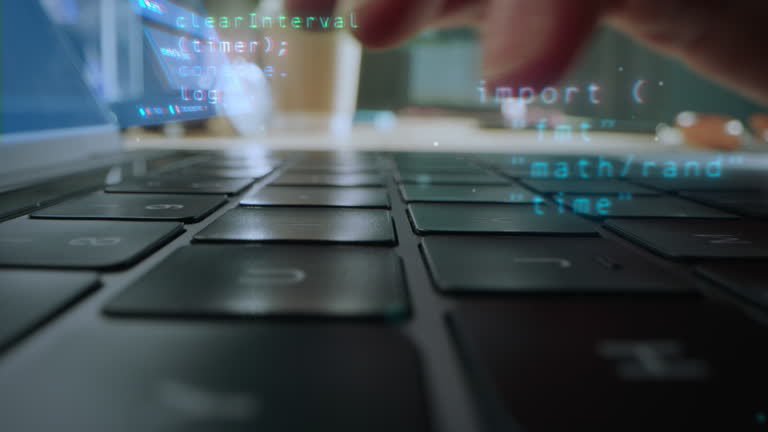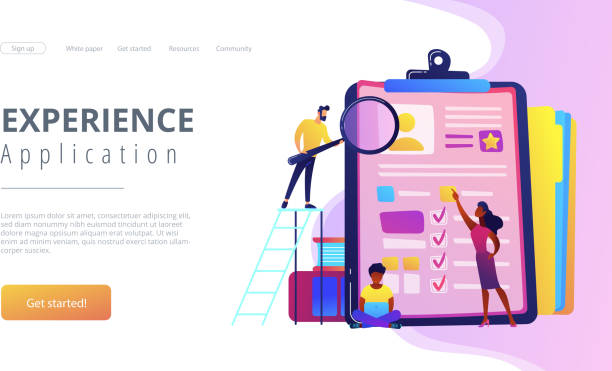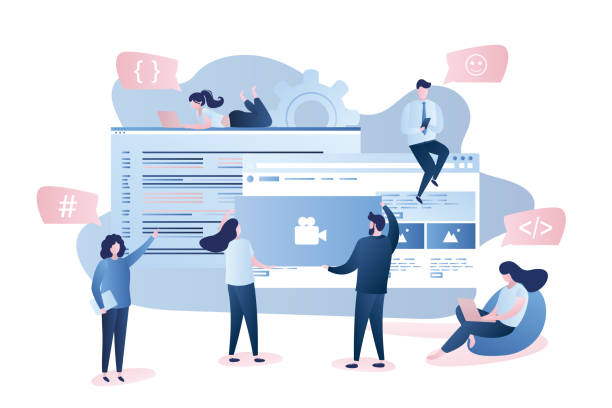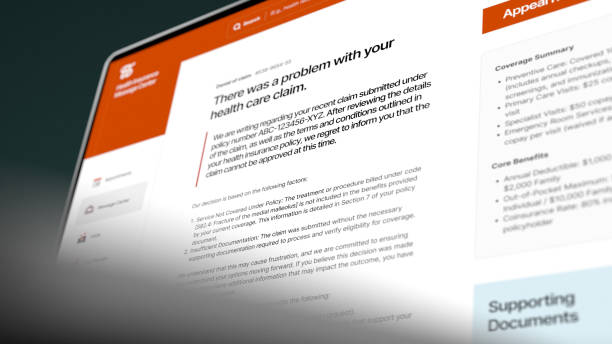Why Secure Website Design is Crucial: An Introduction to Web Security

#Web_Security #Data_Protection #Cyber_Threats
In today’s digital world, where businesses and communications are increasingly moving to the web, the concept of secure website design is no longer an option, but an undeniable necessity.
Imagine your website, the online storefront of your business, suddenly being attacked; customer information stolen, sensitive data exposed, or even the website becoming inaccessible.
Such incidents not only lead to significant financial losses but also cause irreparable damage to your brand reputation and credibility.
The goal of secure website design is to create a reliable online environment resistant to various cyberattacks.
This includes protecting user data, maintaining data integrity, and ensuring continuous access to services.
Many businesses still do not pay enough attention to this critical aspect and face significant risks.
Awareness of existing threats and implementing preventative solutions is the first step towards website security.
With the increasing complexity of attacks, the need for comprehensive and all-encompassing approaches to website security is felt more than ever.
This is an ongoing process that requires continuous updates and diligent monitoring.
Are you dissatisfied with the low conversion rate of visitors to customers on your e-commerce site?
Solve this problem permanently with professional e-commerce website design by Rasaweb!
✅ Increase visitor-to-customer conversion rate
✅ Create an excellent user experience and build customer trust
⚡ Get free consultation
Identifying the Most Common Vulnerabilities and Cyber Threats

#Vulnerabilities #Cyber_Attacks #Social_Engineering
To succeed in secure website design, one must first know the enemy.
The web world is full of threats that are constantly evolving.
Among the most common vulnerabilities targeting websites are SQL injection attacks, through which hackers attempt to inject malicious code into the database and obtain sensitive information.
Another is Cross-Site Scripting (XSS), which allows an attacker to inject client-side scripts into web pages, thereby stealing user information or taking control of their sessions.
DDoS (Distributed Denial of Service) attacks are also carried out with the aim of taking a website offline by sending a massive volume of malicious traffic.
Additionally, flaws in server security configuration, the use of outdated software with known vulnerabilities, and social engineering attacks are also considered serious threats.
Understanding these weaknesses and threats is the foundation of any effective effort to enhance website security.
Continuous analysis of security reports and monitoring developments in cyberattacks help you keep your secure website design strategies up-to-date.
This section provides you with an analytical insight into the breadth and complexity of security challenges.
Best Practices for Secure Coding and Software Development
![]()
#Secure_Coding #Secure_Framework #Input_Validation
One of the main pillars of secure website design is adherence to secure coding principles from the very initial stages of development.
This means writing code that is resistant to common attacks and has minimal vulnerabilities.
The most important principle is thorough and complete input validation.
Any data received from the user must be checked and sanitized for type, format, and content before processing to prevent the injection of malicious code.
Using reputable and up-to-date web development frameworks, which implement many security mechanisms internally, can significantly help reduce security errors.
For example, most modern frameworks offer functions to prevent XSS and CSRF (Cross-Site Request Forgery).
Also, proper error and log management is crucial; log information should not include sensitive data that attackers could exploit.
Furthermore, encrypting sensitive information, using strong hashing functions for passwords, and implementing strict security policies in the database are among the key aspects of secure website design.
Optimizing code for better performance and increased security requires a comprehensive approach where all technical and logical aspects are considered.
| Security Principle | Description | Practical Example |
|---|---|---|
| Input Validation | Thorough examination of all user input data to prevent malicious code injection. | Filtering special characters in forms, checking data type (e.g., numbers only for numeric inputs). |
| Data Encryption | Protecting sensitive information (such as passwords and financial data) using strong encryption algorithms. | Using HTTPS (SSL/TLS) for communications, hashing passwords with strong functions like Argon2 or bcrypt. |
| Secure Error and Logging Management | Providing generic error messages to the user and logging technical details in secure log files. | Not displaying technical error details (such as file paths or database information) in public output. |
| Use of Secure Libraries and Frameworks | Leveraging development tools and frameworks that have implemented security mechanisms by default. | Using Django, Laravel, ASP.NET Core for web development. |
Server and Website Infrastructure Security

#Secure_Configuration #Firewall #SSL_Certificate
Secure website design is not limited to coding; the security of the infrastructure and the hosting server of the website is also of vital importance.
Even with the best secure coding, a website will be vulnerable if hosted on an insecure server.
Proper server configuration, including disabling unnecessary services, changing default ports, and implementing strict access policies, is among the first steps.
The use of firewalls (software and hardware) to control incoming and outgoing traffic and block unauthorized access is essential.
Regular installation and updates of the operating system and all server software (such as web server, database, and programming languages) should also be on the agenda to prevent known vulnerabilities.
The use of SSL/TLS certificates to encrypt communications between the user’s browser and the server is a fundamental principle in web security and assures users that their information is protected during transfer.
Furthermore, restricting access to critical server files, using monitoring systems to identify suspicious activities, and regular data backups are all integral components of a comprehensive server security strategy.
Paying attention to these points provides a robust platform for secure website design.
Are you concerned about the low conversion rate of your e-commerce site and not achieving your desired sales?
Rasaweb is your specialized solution for a successful e-commerce website.
✅ Significant increase in conversion rates and sales
✅ Professional and user-friendly design to attract customer satisfaction
⚡ Ready for a revolution in online sales? Get a free consultation!
Protecting the Database and Sensitive Data

#Database_Security #Data_Encryption #Access_Control
The heart of any website is its database, which contains vital user and business information.
Therefore, database security is one of the most important aspects of secure website design.
One of the fundamental principles is to use separate user accounts with the least necessary privilege (Least Privilege) for applications to connect to the database; meaning each application or service should only have access to the information essential for its operation.
Encrypting sensitive data in the database, such as passwords (using strong hashing and salting), credit card information, or other personal data, prevents serious risks in case of data breaches.
Implementing strong access control mechanisms at the database level is crucial for restricting which users can access specific tables and columns.
Also, one must be wary of SQL injection attacks, as previously mentioned; using Prepared Statements and Parameterized Queries is the best solution to combat these attacks.
Regular updates of the Database Management System (DBMS) and monitoring database logs to identify suspicious activities are important preventive measures.
These measures ensure that website security at the data layer is also managed optimally.
This section clarifies the critical importance of data management and protection within a comprehensive security approach.
User Authentication and Access Permission Management

#Authentication #Session_Management #Secure_Passwords
User security is one of the cornerstones of secure website design.
Proper management of authentication and authorization plays a pivotal role in protecting user accounts and preventing unauthorized access.
Encouraging users to use strong and unique passwords, and implementing mandatory mechanisms such as minimum password length, complexity, and periodic change requirements, are important points.
Additionally, the use of two-factor authentication (2FA) provides an additional layer of security, making it difficult for an attacker to gain access even if the password is compromised.
Proper user session management is also critical for website security; user sessions should expire after a specified period, and session tokens should be generated randomly and with appropriate length.
Preventing Brute-Force and Credential Stuffing attacks by limiting failed login attempts and using CAPTCHA is also essential.
Finally, the access permission system must be carefully designed so that users only have access to the parts of the website they are authorized for, and attempts to access unauthorized sections should be logged and alerted.
These preventive measures ensure that each user operates in a secure environment with their defined access level.
The Importance of Regular Security Audits and Continuous Updates

#Security_Audit #Software_Update #Penetration_Testing
The field of secure website design is not a static process; rather, it requires continuous monitoring and updates.
Even the most secure websites will be vulnerable to new threats that emerge every day.
Regular and periodic security audits, including penetration testing and vulnerability scanning, are essential for identifying hidden weaknesses.
These tests simulate real attacks performed by security experts with the aim of finding gaps before malicious attackers do.
Continuous updating of all software used, from the server operating system to the CMS platform (such as WordPress, Joomla), plugins, themes, and coding libraries, is vital.
Many successful attacks occur due to the use of older software versions with known vulnerabilities.
Furthermore, a clear policy for managing security patches must be in place to address any discovered security flaws as quickly as possible.
Monitoring server and software logs, using Intrusion Detection Systems (IDS) and Intrusion Prevention Systems (IPS) also act as additional layers of defense.
This proactive approach helps you always stay one step ahead of attackers and ensures that your website security is maintained at the highest possible level.
| Activity Type | Suggested Frequency | Description |
|---|---|---|
| Review of Server Security Logs | Daily/Weekly | Monitoring for any suspicious activity or attempted intrusion. |
| Vulnerability Scan | Monthly/Quarterly | Using automated tools to identify known vulnerabilities. |
| Penetration Testing | Annually/After major changes | Simulating real attacks by specialists to discover weaknesses. |
| Software and OS Updates | Immediately after security patches are released | Immediate application of security patches for OS, CMS, plugins, and libraries. |
Incident Response and Disaster Recovery Planning

#Incident_Response #Disaster_Recovery #Backup
Even with the best secure website design approaches, the possibility of a cyber incident never reaches zero.
Therefore, having a well-defined plan for Incident Response and Disaster Recovery is crucial.
These plans specify what actions should be taken in the event of an attack or system failure.
An incident response plan includes stages of identification, containment, eradication, recovery, and lessons learned from the event.
The responsible team must have clear roles and responsibilities and practice various attack scenarios.
Regular and automated backup of website data and code, and storing them in secure and separate locations, are among the most important aspects of disaster recovery.
These backups should be tested periodically to ensure their integrity and restorability.
The main goal of this section of secure website design is to minimize downtime, reduce damages, and quickly restore services.
Transparent communication with users at the appropriate time and after the problem is resolved is also part of your responsibility.
This section helps you be prepared for the worst-case scenarios and protect your business continuity, even when facing unexpected challenges.
Does your current website convert visitors into customers, or does it drive them away? Solve this problem permanently with professional corporate website design by Rasaweb!
✅ Build strong credibility and branding
✅ Attract target customers and increase sales
⚡ Get a free consultation now!
The Role of Training and Awareness in Enhancing User and Team Security

#Security_Training #Social_Engineering #Cyber_Awareness
One of the biggest weaknesses in any security chain is the human factor.
Even with the strongest secure website design and most advanced technical tools, if the website’s users and technical team lack sufficient cybersecurity training, the door will be open for social engineering attacks and human errors.
Regular training for website users on the importance of choosing strong passwords, identifying phishing emails, and warning about suspicious links can significantly increase overall security.
This is especially critical for websites where users enter sensitive information.
On the other hand, continuous training and awareness for the website development and management team regarding the latest threats, vulnerabilities, and best practices for secure coding and server management is essential.
Holding workshops, sharing security news, and fostering a culture of security awareness throughout all stages of the software development lifecycle are effective solutions in this regard.
Establishing a strong security culture within the organization, where every individual understands their responsibility for website security, is key to sustained success.
Secure website design goes beyond technology; it requires a security mindset at all levels.
The Future of Web Security and Emerging Technologies

#Future_Security #Artificial_Intelligence #Blockchain
The world of cybersecurity is constantly changing and evolving, and secure website design must adapt to these developments.
With the emergence of new technologies such as Artificial Intelligence (AI), Machine Learning (ML), and Blockchain, new opportunities have arisen to strengthen website security.
Artificial Intelligence and Machine Learning can be very effective in identifying complex attack patterns, intrusion detection, and predicting future threats, and assist in analyzing vast amounts of security data.
The use of Blockchain to increase transparency and security in identity and access management, as well as protect data integrity, has great potential.
Furthermore, the concept of “Zero Trust Security”, which emphasizes not trusting any user or device, even within the network, is becoming a new standard in website security.
It is anticipated that cyberattacks will also become more complex and sophisticated, so it is imperative to always seek innovative solutions to counter them.
This section looks at the future of secure website design and highlights the importance of staying updated with the latest security technologies and trends so that organizations can maintain their resilience against forthcoming threats.
Frequently Asked Questions
| Row | Question | Answer |
|---|---|---|
| 1 | What is secure website design? | Secure website design is a process where websites are built with security measures considered from the initial stages of development to protect against cyberattacks, unauthorized access, and data loss. |
| 2 | Why is secure website design important? | Website security is crucial for maintaining user trust, protecting sensitive information (personal and financial), preventing damage to brand reputation, and complying with privacy and security regulations (such as GDPR). A security breach can lead to financial and legal losses. |
| 3 | What are the most common cyberattacks a website faces? | Some of the most common attacks include SQL Injection, Cross-Site Scripting (XSS), Distributed Denial of Service (DDoS), Brute Force, and Credential Stuffing attacks. |
| 4 | What is SQL Injection and how can it be prevented? | SQL Injection is an type of attack where an attacker attempts to manipulate the database or extract information by injecting malicious SQL code into site inputs. To prevent it, one should use Prepared Statements/Parameterized Queries, ORM (Object-Relational Mapping), and thorough input validation. |
| 5 | What is Cross-Site Scripting (XSS)? | XSS is an attack where an attacker injects malicious scripts (usually JavaScript) into web pages, which are then executed by other users’ browsers. This can lead to the theft of cookies, session information, or alteration of the website’s appearance. |
| 6 | How can Brute Force attacks on login pages be prevented? | To prevent Brute Force attacks, one should use CAPTCHA, limit the number of failed login attempts (Account Lockout), two-factor authentication (2FA), and use complex and long passwords. |
| 7 | What is the role of HTTPS in website security? | HTTPS encrypts the communication between the user’s browser and the website server using SSL/TLS. This prevents eavesdropping, tampering, or forging of information during transmission and increases user trust. |
| 8 | What is the importance of Input Validation in security? | Input validation is the process of checking and sanitizing data entered by the user. This prevents malicious code injection, XSS attacks, SQL Injection, and other vulnerabilities, ensuring that the data conforms to the expected format. |
| 9 | Why is regular updating of website systems and software necessary? | Regular updates of the operating system, CMS (like WordPress), plugins, themes, and libraries used address known security vulnerabilities. Hackers often exploit weaknesses in outdated software for intrusion. |
| 10 | What role does regular backup play in secure website design? | Regular and tested backup of website data (database and files) is a critical layer of defense against data loss due to cyberattacks, human errors, or hardware failures. This enables quick website recovery in the event of a disaster. |
And other services of Rasa Web Advertising Agency in the field of advertising
Smart Data Analysis: A specialized service for increasing website visits based on marketing automation.
Smart UI/UX: A professional solution to increase sales with a focus on attractive user interface design.
Smart Customer Journey Map: Professional optimization for increasing click-through rates using Google Ads management.
Smart Digital Branding: Designed for businesses seeking to attract customers through marketing automation.
Smart SEO: Designed for businesses seeking to increase click-through rates through marketing automation.
And over a hundred other services in internet advertising, advertising consultation, and organizational solutions
Internet Advertising | Advertising Strategy | Advertorials
Sources
Web Security Guide on ZoomitWeb Design Security Tips on DigiatoWeb Security Threats from ISNA’s PerspectiveSecure Coding Practices on IRNA
? Are you looking to elevate your business in the online space? Rasaweb Afarin, a leading digital marketing agency, is your reliable partner on the path to digital success, offering specialized services including custom website design, professional SEO, and targeted advertising campaigns.
📍 Tehran, Mirdamad Street, next to Bank Markazi, Kazeroun Jonubi Alley, Ramin Alley, No. 6


